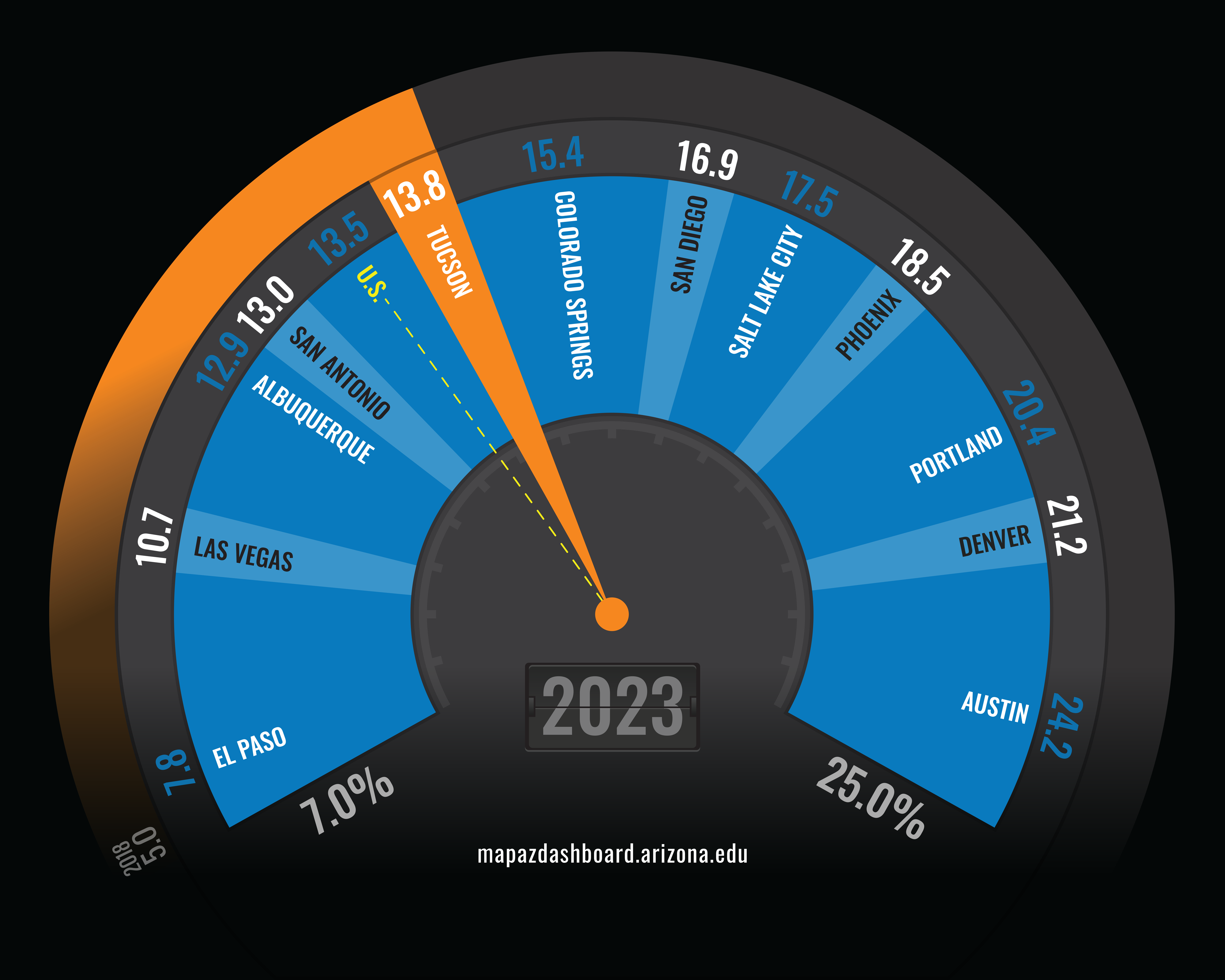 Dive Into Data on Transportation to Work Trends in Tucson, Arizona MSA
Dive Into Data on Transportation to Work Trends in Tucson, Arizona MSA
How are we doing?
Percent of Residents Working From Home (2023)

In 2023, 13.8% of residents in the Tucson Metropolitan Statistical Area (MSA) reported working from home. That ranked Tucson eighth among peer western metropolitan areas. Work-from-home rates skyrocketed during the beginning of the pandemic. Rates varied significantly among MSAs depending on the industrial mix and stay-at-home orders. Keep in mind that the data reported here is from a five-year survey therefore it includes one year of data prior to the pandemic.
Driving alone is the primary mode of transportation to work for most Americans, other modes such as bicycling, walking, carpooling, and public transportation have the potential to reduce congestion and mitigate the impact that driving alone has on the roadways. Those who drove alone in Tucson represented 70.7% of the population, while 9.6% of Tucson residents carpooled to work.
Why is it important?
The prevalence of driving alone as the primary mode of transportation to work for most Americans has had tremendous economic, social, and environmental consequences for our nation. To mitigate these effects, recent transportation-authorization bills have required state transportation agencies to incorporate multimodal considerations into all new transportation planning and programming, through the Intermodal Surface Transportation Equity Act of 1991. Subsequent bills have expanded existing efforts and created new programs to foster alternative transportation options and decrease highway congestion. Examples include limiting the addition of single-occupant vehicle capacity and increasing funding for public transit, bicycling, and walking facilities.
The duration of one’s journey to work, as well as how they get there, reflects both quality of life and economic well-being for a region. Longer commute times are often indicative of a spatial mismatch between jobs and housing – a phenomenon that can especially impact low-income households, as their geographic mobility may be limited. Long commute times can also result from high housing costs, poorly planned transportation networks, and local regulatory policies such as exclusionary zoning.
How do we compare?
In 2023, 70.7% of residents in Tucson reported driving alone as their primary means of transportation to work. This ranked Tucson eighth among 12 western MSAs, of which the Portland MSA ranked first, with the lowest percentage of commuters driving alone at 62.7%. El Paso ranked last with the highest percentage, at 76.3%.
Tucson posted a rate of 1.0% of commuters bicycling to work in 2023, outperforming Arizona and the U.S. by 0.5 and 0.6 percentage points, respectively. Driving alone accounted for more than 70.0% of commuters in Tucson and the U.S., while Arizona had a slightly lower rate. The state posted a higher rate of commuters by carpool than Tucson or the U.S., at 9.8%. Tucson and Arizona were behind the U.S. in the percentage of commuters walking to work, at 1.9% and 1.7%, respectively, in comparison to 2.4% for the nation.
What are the key trends?
The percentage of commuters driving alone decreased across Tucson, Arizona, and the U.S. since 2018. That is likely due to more individuals working from home since the pandemic.
In 2023, the mean commute time for the Tucson MSA was 24.4 minutes, slightly shorter than the statewide average for Arizona at 25.5 minutes. Both Tucson and Arizona enjoy shorter commute times than the national average of 26.6 minutes. Commute times in Tucson and Arizona have seen little change since 2000.
How is it measured?
Transportation-to-work data are from the U.S. Census Bureau’s American Community Survey (ACS) five-year estimates. The ACS is a nationwide rolling sample survey that produces one-year and five-year estimates on demographic, social, housing, and economic measures. Note that the ACS five-year estimates are produced over a five-year time period and can only be compared to non-overlapping five-year estimates (for example 2005-2009 and 2010-2014). Data used include the percent of total travelers to work, by mode of transportation: drove alone, carpooled, public transportation, walked, bicycle, taxi or other, and worked at home.












